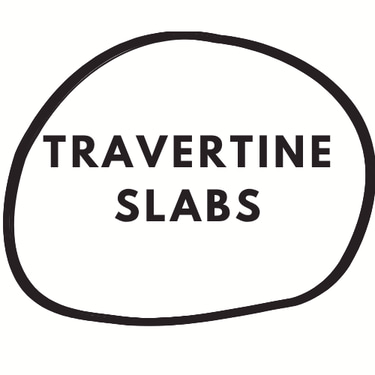What is Travertine?
Travertine is a type of natural stone formed from limestone deposits created by mineral springs, especially hot springs. Over thousands of years, layers of calcium carbonate build up and solidify into a beautiful, durable stone with a distinctive texture and natural pores.
This unique stone is valued for its warm, timeless appearance and has been used in architecture for centuries — from ancient Roman buildings to modern luxury interiors.
Key characteristics of travertine:
Natural veining and subtle color variations,
Earthy tones such as beige, cream, silver, gray, and walnut,
A surface that can be polished, honed, tumbled, or brushed, depending on the desired finish,
Durability suitable for both interior and exterior applications.
Travertine is commonly used for flooring, wall cladding, bathroom tiles, countertops, stairs, and facades, adding elegance and a touch of nature to any design.
How Travertine is Formed?
Travertine is a natural sedimentary stone formed through a fascinating geological process that takes thousands of years. It develops when mineral-rich groundwater or hot springs deposit calcium carbonate (CaCO₃) on the Earth’s surface or in underground caves.
As water evaporates, the calcium carbonate crystallizes and builds up in layers, creating the porous and layered structure characteristic of travertine. Over time, pressure and natural chemical reactions solidify these deposits into stone.
The stone often forms near limestone caves, rivers, and geothermal areas, where mineral springs are active. Its unique texture and veining result from the flow of water, temperature changes, and mineral impurities, which give travertine its range of natural colors — from ivory and beige to silver, gray, and walnut brown.
This slow, natural formation process makes every piece of travertine truly unique, with distinct patterns and tones that cannot be replicated artificially.


Travertine Colors and Shades
Travertine is known for its rich variety of natural colors and tones, created by minerals present during its formation. Each block of stone carries a unique combination of hues, giving travertine its timeless and elegant character.
The most popular travertine colors and shades include:
Ivory / Cream – soft, light beige tones that bring warmth and brightness to any space,
Beige / Navona – classic and versatile, ideal for traditional and modern interiors alike,
Silver / Silver Ash / Silver Latte – elegant gray tones with subtle beige or brown veining, perfect for contemporary designs,
Walnut / Noce – rich brown and chocolate shades that add depth and sophistication,
Bianco / White – clean, light tones that create a luxurious and spacious look,
Gray / Etrusco – cool and refined, with natural variations from light to dark gray,
Green Travertine – a rare and distinctive option that introduces a natural, earthy aesthetic.
Because travertine is a natural stone, every piece varies slightly in pattern and tone — from soft, uniform surfaces to dramatic veining. These natural variations are what make travertine unique and highly valued in architecture and interior design.
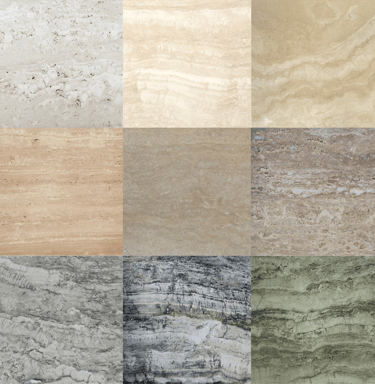

Where Travertine Occurs?
Travertine naturally forms in areas with active hot springs, limestone caves, and geothermal activity, where mineral-rich water deposits calcium carbonate over time. These environments create the ideal conditions for travertine to develop its signature layered and porous structure.
Today, travertine is quarried in several regions around the world, but the most renowned deposits are found in:
Italy – especially in Tuscany and Lazio, home to famous quarries such as Saturnia Travertini Italia in Manciano, known for premium varieties like Bianco Maremma, Montemerano Classico, and Etrusco,
Turkey – one of the largest producers of travertine, particularly in the Denizli region,
Iran – known for warm beige and cream tones,
Mexico and 🇺🇸 the United States (especially in Idaho and Texas) – offering lighter, modern color variations,
Spain and 🇫🇷 France – with smaller but high-quality quarries.
Each region’s geological conditions give travertine its own distinct color palette and texture, making this stone truly one-of-a-kind. Italian travertine, for example, is particularly prized for its elegant veining, durability, and timeless beauty, often used in both classic and modern architectural projects.
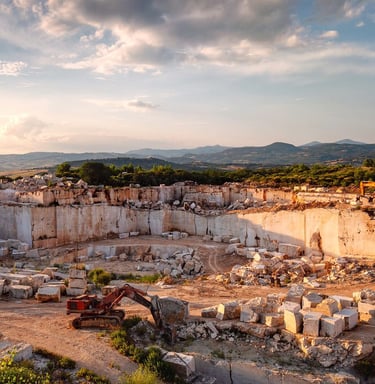

Travertine in Construction
Travertine has been used in architecture and construction for thousands of years, admired for its natural elegance, strength, and versatility. Ancient Romans used it to build monumental structures such as the Colosseum in Rome, which still stands as a testament to the stone’s durability.
In modern construction, travertine remains one of the most popular natural stones thanks to its timeless appearance and adaptability. It can be used for both interior and exterior projects, including:
🏠 Flooring and wall cladding – adds warmth and sophistication to homes, hotels, and public spaces,
🧱 Facades and elevations – provides a natural and luxurious finish to buildings,
🪜 Stairs, fireplaces, and columns – enhances architectural details with a refined look,
🪴 Outdoor applications – ideal for terraces, pool surrounds, and garden paths due to its slip-resistant surface,
🪟 Countertops, sinks, and decorative elements – used in bathrooms and kitchens for its aesthetic and natural texture.
Travertine’s porous structure allows it to breathe and regulate moisture, making it especially suitable for Mediterranean climates. When properly sealed and maintained, it can last for generations, combining practicality with timeless beauty.
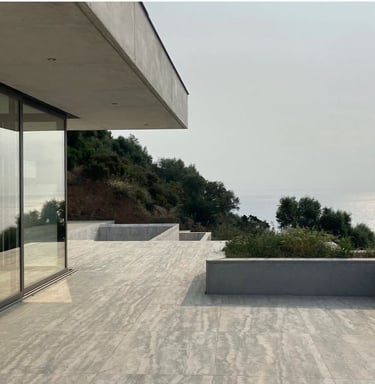

Travertine Hardness of Natural Stone
Travertine is classified as a medium-hard natural stone, positioned between soft limestone and hard marble on the Mohs hardness scale, where it typically ranges from 3 to 4. This means it is strong enough for most architectural applications, yet soft enough to be easily cut, shaped, and polished, which makes it a favorite material for designers and architects.
Its porous structure is one of the key features that distinguishes travertine from other stones. These natural pores form during the stone’s creation, as mineral-rich water leaves air pockets inside the rock. Because of this, travertine requires filling and sealing to improve durability and protect the surface from moisture, stains, and dirt.
Despite its relative softness compared to granite or quartzite, travertine is highly resistant to temperature changes, compression, and aging. With proper maintenance, it retains its natural beauty for decades, even in outdoor environments.
In summary, travertine offers the perfect balance between durability and workability — strong enough for heavy use, yet delicate enough to bring a natural, elegant touch to any construction or design project.
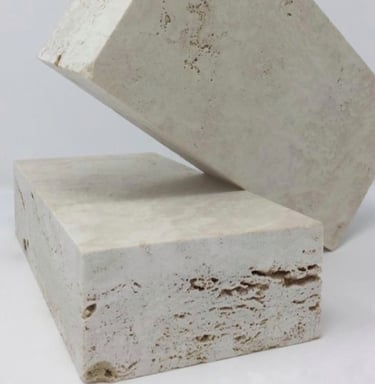

Travertine Slabs
Discover exquisite travertine slabs, tiles, block today.
CONTACT
© 2025. All rights reserved.
